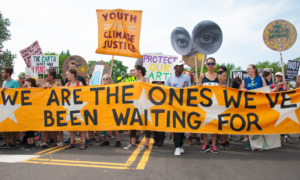BY HOLLIE I. WEST
People in youth work are rarely neutral about Jerome G. Miller.
“Probably the greatest reformer the field of juvenile justice has ever seen,” declares Dan Macallair, a vice president in the San Francisco office of the Center on Juvenile and Criminal Justice.
“He manages by chaos,” says attorney Elizabeth Siegel, co-founder of DC Action for Children in Washington, D.C.
“He’s not afraid to make enemies,” says Peter Greenwood, a senior scholar at the RAND Corporation.
Good thing. For during his 30 years in juvenile justice and child welfare, Miller’s M.O. has been to push for immediate change, confront and not compromise with critics, remove power and prerogatives from social welfare professionals and ignore bureaucratic protocol.
His theories and methods spark admiration and support from some, and harsh opposition and political rebuke from others. “He’s so reviled because he not only challenged the status quo, but he changed it,” Macallair says.
Quick Change
Miller, 69, sounds reasonable. “We try to do for the average offender what a thinking, compassionate, middleclass parent or brother or son would do for someone in their family were they in trouble,” he says in the offices of the Alexandria, Va.-based National Center on Institutions and Alternatives, a criminal justice and human service agency he co-founded in 1977.
It’s not his advocacy of community therapy settings (rather than large institutions) for youth offenders and foster children that drives his critics crazy. Nor is it his championing of sentencing alternatives – community service, victim restitution, drug or alcohol treatment and neighborhood supervision – for anyone who otherwise would be incarcerated. He espouses making neighborhoods responsible for providing foster care for their own residents, and mitigative studies for people tried for capital offenses. Such once cutting-edge theories are accepted in many circles today and might be considered moderate reforms at a time when some lawmakers applaud boot camps and chain gangs.
It’s Miller’s damn-the-torpedoes style that riles. Greenwood, from the criminal justice program at RAND, calls Miller an “original thinker” averse to compromise. “He wants change immediately. He’s kind of a Ralph Nader character.”
“Our primary difference with him was that he was making a reputation for himself by emptying out institutions and using untrained caseworkers,” says Chauncey Alexander, retired executive director of the National Association of Social Workers. “We disagreed with his methodology.”
Take Miller’s latest big brush with the public social welfare bureaucracy, when he served as general receiver for the child welfare system in the District of Columbia from 1995-97. Before his appointment, Miller noted that management was not his strong suit and that city bureaucrats were probably not ready for his approach. Sure enough, his ambitious plans for decentralizing services, starting neighborhood collaborations and reuniting children with their families ran into a bottleneck of opposition from front-line staff members.
“He wrote a lot of plans, but nothing got accomplished,” says Siegel of DC Action for Children.
Opposition Everywhere
Miller’s D.C. experience fit a pattern. In Pennsylvania, as commissioner of children and youth in the mid-70s, he pulled 400 youths out of the Camp Hill corrections facility, which he called a “human sewer,” and shut down a reform school in Warrendale. But his plans for community facilities ran into massive opposition from juvenile court judges.
In 1973, as director of the Illinois Department of Children and Family Services, he brought back more than 800 children who had been farmed to out-of-state child welfare agencies. He embarked on creating a communitycentered foster care system, but political opposition blocked the plan.
“He has a passion for deinstitutionalization,” says Jerry Stermer, president of Voices for Illinois Children, a Chicago-based child advocacy group. “But he doesn’t have the patience to move at a slow pace. He looks at change in stark black and white terms, not grays.”
In 1969, as commissioner of youth in Massachusetts, Miller closed all the state’s reform schools and replaced them with a network of community-based programs. Under his direction, delinquent youths were allowed to do things such as go sailing and chase humpback whales. His moves brought scathing criticism from judges and social welfare professionals, among others.
The idea of therapeutic communities was new to politicians and social workers, and is still not embraced by all in government or social welfare. For Miller, the idea went back to his days as an Air Force psychiatric social work officer in England in the 1960s.
The Road to Advocacy
Miller had significant encounters with A.S. Neill, founder of the Summerhill school for troubled children and author of a popular book by the same name, and with psychoanalyst George Lyward, organizer of a therapeutic community for troubled adolescents in a monastery in Kent during World War II.
“I got immersed in these models,” recalls Miller. Lyward’s program, “a place of openness, unconditional care and emotional growth,” Miller once wrote, became the standard he tried to apply in Massachusetts.
Perhaps Miller, who grew up in the small town of Wahpeton, N.D., began heading toward these ideas during his formative years at the now-defunct Maryknoll College, a Catholic seminary in Glen Ellyn, Ill. There he was deeply influenced by the teachings of the Maryknoll order, a missionary group devoted to working for international social justice. After graduation Miller went to a farm outside Bedford, Mass., for a novitiate year when talking usually was not allowed except on weekends.
“We didn’t have toilets,” he recalls in his low-key, nonstop speaking style. “We did our own butchering. I found that to be the best year of my life. I thought through some things and decided it [the missionary life] was not for me.”
Now Miller promotes his ideas with missionary zeal in other ways – lecturing, writing and working through the National Center on Institutions and Alternatives. He and his co-founders started the center with $500, printing a newsletter about youth issues and problems in institutions.
Today the NCIA has a $10 million budget and about 200 staffers in offices in Alexandria and Baltimore. It directs criminal justice programs addressing alternative sentencing, sexual disorders, severely retarded adults and emotionally disturbed youngsters, and public policy. Director Herb Holter, one of the co-founders, manages the center; Miller writes and lectures. He is finishing a book on child welfare reform.
Years of fighting have not deflected him from his vision of making criminal and juvenile justice, as well as child welfare, more responsive to individual needs. He says too many behavioral patterns – social and psychiatric problems, community health problems – are being criminalized.
“We don’t want to hear about case histories. We have mandatory sentences. We don’t want to hear about the person, hear his history, meet the family, because that makes it more difficult to be punitive. We just want to hear the crime and the time.”































